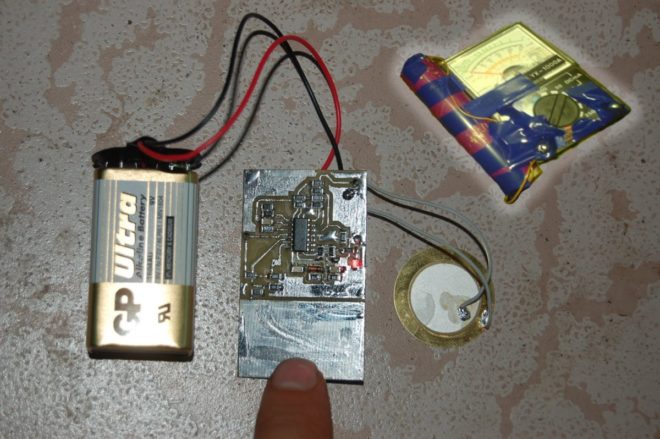DIY hidden wiring finder (detector)

Sometimes the problem of finding hidden wiring during apartment renovation becomes a real torment. To avoid this, you need to have a wall wiring detector in your home toolbox. Such devices are commercially available, but if you like to create home-made devices and do not want to spend money on buying a factory product, you can assemble an apparatus that will help you find out, if necessary, where the walled wiring passes, on your own. From this material, you will learn what a hidden wiring finder is, what types of these devices exist and how you can make such a detector with your own hands.
Content
- Varieties of wiring finders
- How to find electrical wiring in walls using a voltage indicator?
- Assembling the field-effect transistor wiring finder
- Detector with a field effect transistor: how to work
- Detection of wiring in the wall by electromagnetic radiation
- Improved homemade qualifiers
- Search for dead wires
- Find hidden wires with Android
- Conclusion
Varieties of wiring finders
There are four types of these devices, which differ from each other in their principle of operation. Each of them detects hidden electrical wiring in the wall by various physical parameters, and they are named accordingly:
- Electrostatic. Their work is based on the search for an electric field, which is created by voltage. This design is the simplest, and it is not difficult to make it at home.
- Electromagnetic. Such devices detect the magnetic field that is created by the flow of electrons in the wiring.
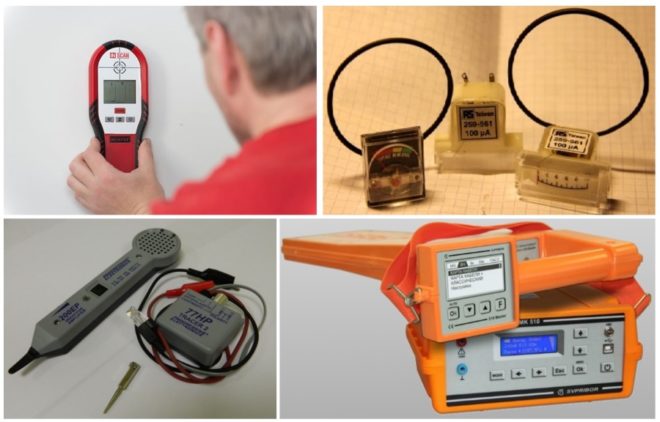
- Inductive metal detectors. These devices create an electromagnetic field themselves, and by the changes that have arisen in it, they detect the metal of de-energized cables.
- Combined factory appliances. These are the best, sensitive and accurate devices used for professional work, but their price is the highest in comparison with other types of wiring detectors.
The finder of the wiring hidden in the wall is often built into the circuit of multifunctional devices intended for servicing electrical networks. The most famous of these is the Woodpecker. This device combines several useful devices at the same time.
Varieties of devices for finding hidden wiring and testing them on video:
How to find electrical wiring in walls using a voltage indicator?
The easiest way to determine where the hidden wiring runs is with an improved voltage indicator (sonic screwdriver). This device is self-powered, in addition, it includes an audible alarm and signal amplification means.
If you have such a tool, then you do not need to make the hidden wiring indicator yourself or make any changes to the device circuit. It is not difficult to find hidden electrical wiring with its help.
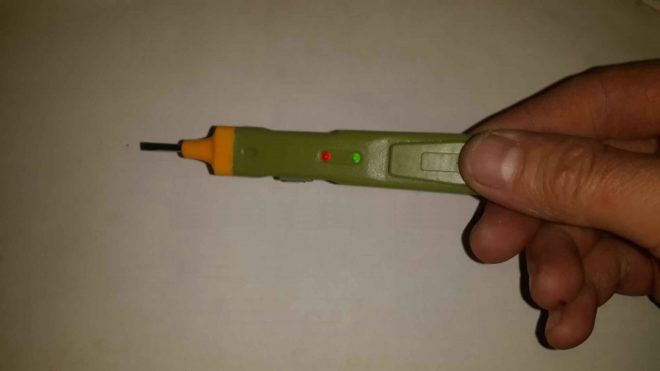
Just use the tip of this screwdriver to run your finger across the wall. The instrument will react to the electromagnetic pulses emitted by the electrical wiring and notify you with a sound that it is located where they are present.
Assembling the field-effect transistor wiring finder
The easiest way is to assemble your own hidden wiring detector, in the circuit of which there is a field-effect transistor. The principle of operation of this apparatus is based on the registration of an electric field.
To assemble such a determinant, you do not need to be a professional; it is enough to have minimal electrical knowledge.
This diagram connects the following elements:
- Field-effect transistor (KP103, KP303).
- Speaker with a resistance indicator of 1.6-2.2 kΩ.A part from a landline telephone set will do.
- Battery (1.5-9 V).
- Switch.
- Connecting cables.
The circuit is assembled by soldering. A simple plastic container with a small volume can be used as a housing for the mounted device.
In the video, an example of assembling a homemade wiring finder:
It must be borne in mind that the field-effect transistor is easily subject to electrostatic breakdown. Therefore, when connecting it to the circuit, do not touch the terminals with your fingers.
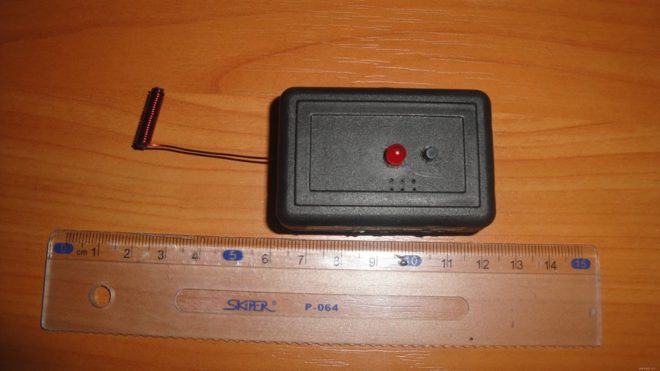
In addition, the tweezers and the soldering iron must be grounded.
Detector with a field effect transistor: how to work
The device operates according to the following principle. The electric field acting on the n-p junction leads to a change in the thickness of the latter, as a result of which its conductivity also changes. Since the change in the electric field coincides with the mains frequency (50 Hz), an increasing hum will be heard from the speaker when approaching the wiring. In order not to confuse the leads of the field-effect transistor, it is necessary to check their marking.
It is desirable that the body of the transistor is metal, connected to the gate, which acts as a control output in this circuit. The body part will act as a receiving antenna that picks up the signal emitted by the wiring.
Assembling a finder of wiring hidden in the wall according to this scheme is no more difficult than the simplest electrical circuit that schoolchildren make in physics lessons, so such work is unlikely to cause difficulties even for an inexperienced master.
To visually display the process of determining the wiring existing in the wall, connect the switch device in parallel with the source-drain electrical circuit. The indicator must include a ballast resistor. The resistance element rating can range from 1 to 10 kΩ.
As the transistor closes, which occurs when it approaches the wiring, an increase in the indicator readings will be noticeable. This will indicate that there is voltage in the cables inside the wall, and therefore an electric field.
Detection of wiring in the wall by electromagnetic radiation
Another type of homemade wiring finder is a milliammeter connected to a high resistance inductor. The latter can be made independently in an arched shape. Also, you can use the primary transformer winding as it, removing part of the magnetic circuit.
This meter does not need a supply element - the inductor included in its composition will contribute to the appearance of alternating current, and the milliammeter will show its presence.
Often, a pickup head removed from an old tape recorder plays the role of a receiving antenna, which is connected using a shielded wire in order to facilitate search. The frequency of sound vibrations in this case will also be 50 Hz, and the intensity of the hum coming from the speaker will be influenced by the magnitude of the current passing through the wires and the distance from the finder to the wiring.
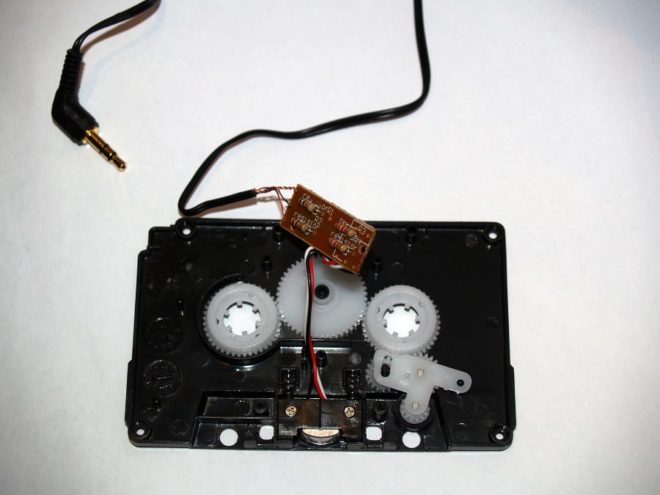
Improved homemade qualifiers
High selectivity and sensitivity are possessed by devices for finding wiring, assembled on the basis of bipolar transistors, as well as operational amplifiers, which include parts of logic microcircuits.
To manufacture an apparatus according to these schemes, you need to understand the radio model at least at a basic level in order to understand how the elements used interact with each other.
There are two main principles by which these devices work:
- Using the strength of the magnetic field generated by the wiring. In accordance with it, the audible tone of the siren changes, as well as the frequency of the visible signal. The receiving element of such a device is a component of the frequency control circuit of a one-shot (multivibrator) generating electrical pulses.This detector can be assembled on the basis of an operational, logic chip, or bipolar transistors.
- Strengthening the sounder signal with a simultaneous deflection of the pointer arrow. In this case, the circuit is improved, the basis of which is a field-effect transistor or a receiving antenna. The role of the latter is played by an inductor with the addition of step-up stages.
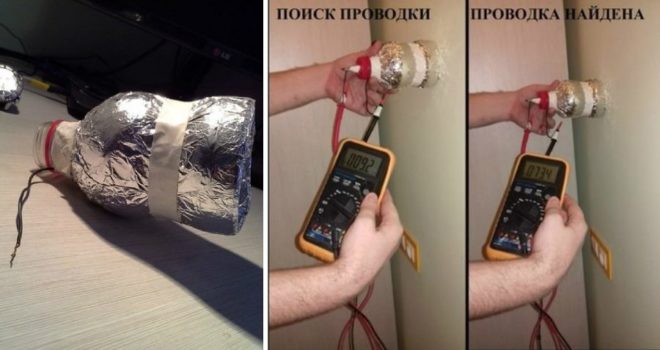
Although it is not very difficult to make such a determinant, its work is associated with certain disadvantages. These include, firstly, the narrow detection range of hidden wiring, and secondly, the need for the presence of voltage in the cables.
Search for dead wires
To find cables in walls that are thick or consist of a very dense material (for example, reinforced concrete), if it is impossible to apply voltage to them, you should use an accurate detector that functions like a metal detector.
Such devices have a complex design, and making a good finder is possible only if you are professionally versed in radio engineering, and also have measuring equipment and all the elements necessary to assemble a circuit. Moreover, such work is not justified from an economic point of view. If you do not have the proper experience and element base, it is better to buy some of the popular and proven devices in the store, for example, BOSCH or "Woodpecker".
Find hidden wires with Android
Did you know that if you have a tablet computer or at least an Android smartphone, then you can detect the wiring in the wall with it? To do this, you need to have the appropriate software installed on the device, which can be downloaded from the GooglePlay application.
These devices are equipped with a built-in module that functions as a navigation compass. Installing the desired program allows you to use it like a metal detector. Of course, if you are looking for a treasure buried in the ground, Android will be useless, but it is quite possible to find cables hidden in the wall with it, if they are not too deep in its thickness.
The principle of operation of the device on video:
It makes no sense to use an Android device to search for wires in thick walls, as well as in reinforced concrete panels. In this case, you cannot do without a professional metal detector.
Conclusion
Now you know what a wiring detector is, what types of these devices are and how they work, as well as how to make a do-it-yourself wiring detector hidden in the wall. If you are interested in radio engineering and love assembling electrical circuits yourself, you will certainly be intrigued by the opportunity to make such an interesting device. If assembling electrical circuits is not your hobby, then you can purchase such a detector in a specialized store.

